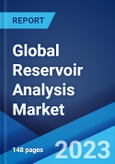The global reservoir analysis market size reached US$ 9.1 Billion in 2022. Looking forward, the market is expected to reach US$ 14.5 Billion by 2028, exhibiting a growth rate (CAGR) of 8.07% during 2022-2028.
Reservoir analysis helps collect critical data from downhole temperature for subsea safety systems and evaluate the performance of an oil reservoir in real-time. It assists in determining water encroachment rates and flow-related properties of the fluids. It also helps explorers understand reservoir behavior for appropriate production procedures and optimize the recovery techniques. At present, it is widely employed in the oil and gas industry to enable better decision-making and get a full view of permeability, skin, and initial pressure of the reservoir.
Reservoir analysis helps collect critical data from downhole temperature for subsea safety systems and evaluate the performance of an oil reservoir in real-time. It assists in determining water encroachment rates and flow-related properties of the fluids. It also helps explorers understand reservoir behavior for appropriate production procedures and optimize the recovery techniques. At present, it is widely employed in the oil and gas industry to enable better decision-making and get a full view of permeability, skin, and initial pressure of the reservoir.
Reservoir Analysis Market Trends
With the decreasing discovery rate of new oil reserves, the focus has shifted to efficient development and evaluation of existing reserves. This, in confluence with the enactment of stringent laws by governing agencies of several countries for resource conservation and recovery, represents one of the key factors bolstering the market growth. Apart from this, the surging consumption of energy on account of rapid urbanization and the rising utilization of electronic appliances is positively influencing the use of reservoir analysis to enhance productivity and accuracy of oil and gas exploration projects. Moreover, the integration of advanced technologies, such as sensors, data acquisition, and amplitude preserving, is driving the demand for reservoir analysis as it aids in getting actionable data, automated measurements, and real-time monitoring statistics. Furthermore, several manufacturers are introducing innovative tools to improve their market presence and gain a competitive edge in the market. For instance, Probe Holdings, Inc., which is a leading oil and gas equipment manufacturer, launched a three-detector pulsed-neutron tool to diagnose production problems and locate bypassed pay zones. The tool uses sigma and carbon-oxygen (C/O) techniques to measure reservoir fluid saturation of oil, water, and gas accurately.Key Market Segmentation
This research provides an analysis of the key trends in each sub-segment of the global reservoir analysis market report, along with forecasts at the global, regional and country level from 2023-2028. The report has categorized the market based on service, reservoir type and end user.Breakup by Service:
- Reservoir Simulation and Geo Modeling
- Reservoir Sampling Service
- Data Acquisition and Monitoring
Breakup by Reservoir Type:
- Conventional
- Unconventional
Breakup by End User:
- Onshore
- Offshore
Breakup by Region:
- North America
- United States
- Canada
- Asia-Pacific
- China
- Japan
- India
- South Korea
- Australia
- Indonesia
- Europe
- Germany
- France
- United Kingdom
- Italy
- Spain
- Russia
- Latin America
- Brazil
- Mexico
- Middle East and Africa
Competitive Landscape
The competitive landscape of the industry has also been examined along with the profiles of the key players being Baker Hughes Company (General Electric Company), CGG, Core Laboratories N.V., Emerson Electric Co., Expro Group, Halliburton Company, Paradigm Group B.V., Probe Holdings Inc., Schlumberger Limited, SGS SA, Tracerco (Johnson Matthey Plc), Trican Well Service Ltd., and Weatherford International Ltd.Key Questions Answered in This Report:
- How has the global reservoir analysis market performed so far and how will it perform in the coming years?
- What has been the impact of COVID-19 on the global reservoir analysis market?
- What are the key regional markets?
- What is the breakup of the market based on the service?
- What is the breakup of the market based on the reservoir type?
- What is the breakup of the market based on the end user?
- What are the various stages in the value chain of the industry?
- What are the key driving factors and challenges in the industry?
- What is the structure of the global reservoir analysis market and who are the key players?
- What is the degree of competition in the industry?
Table of Contents
1 Preface3 Executive Summary11 Value Chain Analysis13 Price Analysis
2 Scope and Methodology
4 Introduction
5 Global Reservoir Analysis Market
6 Market Breakup by Service
7 Market Breakup by Reservoir Type
8 Market Breakup by End User
9 Market Breakup by Region
10 SWOT Analysis
12 Porters Five Forces Analysis
14 Competitive Landscape
Companies Mentioned
- Baker Hughes Company (General Electric Company)
- CGG
- Core Laboratories N.V.
- Emerson Electric Co. Expro Group
- Halliburton Company
- Paradigm Group B.V.
- Probe Holdings Inc.
- Schlumberger Limited
- SGS SA
- Tracerco (Johnson Matthey Plc)
- Trican Well Service Ltd.
- Weatherford International Ltd.
Methodology

LOADING...
Table Information
| Report Attribute | Details |
|---|---|
| No. of Pages | 148 |
| Published | November 2023 |
| Forecast Period | 2022 - 2028 |
| Estimated Market Value ( USD | $ 9.1 Billion |
| Forecasted Market Value ( USD | $ 14.5 Billion |
| Compound Annual Growth Rate | 8.1% |
| Regions Covered | Global |
| No. of Companies Mentioned | 12 |









